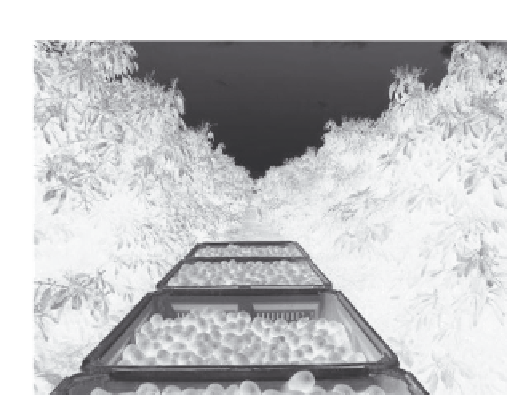Agriculture Reference
In-Depth Information
optimal point, its post-harvest life could be diminished. In
order to determine this optimal harvest point some indices
are used; the most important are two quantitative indices:
oil and dry matter content. However, other complementary
indices can be considered, such as flesh softening and
change of skin colour from green to black in some cultivars
such as 'Hass'. Determining when to harvest avocados
requires experience. Slight changes in skin colour, loss of
glossiness or a brown seed coat are signs of maturity.
Oil content is an important factor in the taste of avocado
fruit. Percent of dry matter is highly correlated with oil
content and is used as a maturity index in most avocado
production areas (Lee
et al
. 1983). Minimum dry matter
content required ranges from 17% to 25%, depending on
cultivar. In California, the minimum percentage of dry
matter at harvest for the major cultivars are Bacon (17.7%),
Fuerte (19.0%), Gwen (24.2%), Hass (20.8%), Pinkerton
(21.6%), Reed (18.7%) and Zutano (18.7%). In California,
fruit are also released onto the market at predetermined
dates based on dry matter and size for each cultivar. For
example, the size/release dates for 'Hass' are Size 40 and
greater, November 28; Size 48, December 12; Size 60,
January 2; and Size 70 or smaller, January 16. Based on the
experiences obtained in Mexico for export fruit, it can be
established that avocados should have an average of 22%
of dry matter, and the lowest value of a sample should not
be under 20%. The California regulation defined minimum
maturity of avocado fruit as containing 21% dry matter
content. In 1983, dry matter content has become an index
of maturity for the California avocado industry and has
been followed by the Mexican avocado growers
(Kurlaender 1996). In order to have a high-quality product,
a 25% dry matter content in the fruit is required. This also
equates to about 13% oil content. Although harvesting of
the fruit for fresh market starts when the dry matter reaches
21%, it is not yet suitable for processing. This is due to lack
of the typical nutty flavour; the colour of the pulp would be
pale green and the viscosity of the product would be too
low (runny) (Kurlaender 1996). Florida (West Indian)
avocados have lower oil content (3 to 15% oil) and are
generally harvested at a specified calendar date (days after
full bloom) and weight or size (Ahmed & Barmore 1980).
Dry matter is measured by placing approximately 10 g of
thin slices of avocado pulp into Petri dishes. The uncovered
dishes are placed in a microwave oven and cooked until
constant weight (from 5 to 15 min) (Clark
et al
. 2003).
Some attempts have been tried to determine fruit
maturity nondestructively, on the tree, before harvest, such
as with the use of near-infrared (NIR) technology
(Brown & Sarig 1994).
Figure 8.1
Avocado harvesting. Courtesy of Dr Mary
Lu Arpaia, University of California, Riverside, CA.
HARVESTING
Fruit are commonly hand-harvested when mature, using an
array of picking aids, such as the use of ladders, telescopic
poles fitted with a cutting blade and catch bag, hand clip-
pers, etc. In some extended orchards, trees are sometimes
harvested with the aid of hydraulic ladders (cherry pickers)
while in smaller orchards picking poles are used to reach
the fruit. In flat areas in California, man-positioning
machines are used to lift the pickers. Fruit are picked into
large bins usually mounted on trailers to facilitate their
movement to the packing shed (Figure 8.1). The fruit is
removed from the tree by either clipping or snapping the
stem at the base of the fruit. For most cultivars, fruit needs
to be clipped with a 'button' retained on the pedicle end.
This reduces the chance of bruising and puncturing adja-
cent fruit once they are placed in containers (Ahmed &
Barmore 1980), and the risk of stem-end rot invading the
fruit as it ripens. The lack of stem end 'button' was shown
to promote fungi spores to grow and discolour the interior
of the fruit after ripening (Kurlaender 1996). The effective-
ness of snap harvesting is dependent upon fruit maturity,
growing conditions (rain) and cultivar (Arpaia & Hofshi
1998). Damage could be caused by improper harvesting,
like pulling or plucking the avocados, instead of clipping
the stem flush with the fruit surface.
It is important to keep the fruit out of direct sunlight
after picking to prevent it from heating. It has been reported
that exposure of the fruit to direct sunlight can result in
temperatures in excess of 15°C above the ambient air
temperature (Ferguson
et al
. 1998). However, fruit exposed
to the sun before harvest have been reported to have higher






























